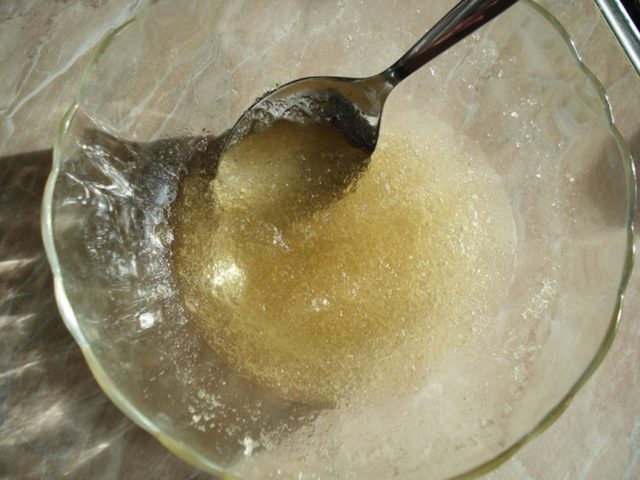Content
- 1 What are collagen and gelatin
- 2 How much collagen is in gelatin
- 3 What is the Difference Between Collagen and Gelatin
- 4 Can you drink gelatin instead of collagen?
- 5 How to take gelatin instead of collagen
- 6 Which is better to take: gelatin or collagen
- 7 Conclusion
- 8 Reviews of taking gelatin instead of collagen
Collagen and gelatin are not just put on the same level in terms of benefits for the human body. To maintain joints, skin, cartilage and bones in the right condition, a special protein is needed, which is collagen. Gelatin is one of the richest sources of this substance. However, experts recommend using not a product as a food additive, but preparations containing it.
What are collagen and gelatin
To understand if gelatin can be taken instead of collagen, you need to understand the terminology. Collagen is a connective protein that is a rich source of amino acids. It is part of the connective tissues, ensuring their strengthening and preventing destruction. The beneficial substance is responsible for the elasticity of the skin, the strength of nails and hair, and also provides joint mobility. It enters the body with food. With its lack, the reception of specialized vitamin complexes is indicated. They accelerate tissue regeneration and help maintain youth. Doctors often prescribe dietary supplements in the period after surgery. This allows the body to recover faster and avoid possible complications. In the manufacture of such preparations, the protein is subjected to multiple processing. Thanks to this, it is absorbed by the human body by almost 90%. The beneficial properties of structured protein include:
- giving the skin elasticity;
- acceleration of regenerative processes;
- improving the condition of nails and hair;
- strengthening of the immune defense;
- normalization of the digestive system;
- regulation of hormonal levels;
- increasing the body's endurance.

Gelatin is a form of collagen used in cooking. It acts as a thickener for desserts, drinks and main courses. Compared to hydrolyzed protein, it is more natural and more affordable. The disadvantages of the product include slow digestion. At the same time, gelatin contains collagen of the first and third types, which makes it a good alternative to popular dietary supplements.
How much collagen is in gelatin
Not everyone knows that gelatin can be used as a source of collagen. 10 g of the product contains the daily dosage of the beneficial substance. Experts recommend using it in this amount. The detailed composition is as follows:
- 9% alanine;
- 22-35% glycine;
- 12-15% hydroxyproline;
- 8% arginine;
- 10% glutamine;
- about 27% of other amino acids.
What is the Difference Between Collagen and Gelatin
Hydrolyzed collagen is significantly different from gelatin. In production, it undergoes multi-stage processing, during which it becomes easily digestible. In addition, they have different reactions to liquids. The hydrolyzate can dissolve in both cold and hot water. Gelatin is resistant to the former. To dissolve it, you need to warm up the water. When mixed with any liquid, it becomes gelatinous.A structured protein in a similar situation does not give any reaction. It is often used for medicinal purposes. The natural analogue is most often used for the prevention of various diseases and preservation of youth.
Can you drink gelatin instead of collagen?
Considering the same origin, collagen can be replaced with gelatin. It is a natural food source of protein. Moreover, the substance has no taste. It is advisable to add it when cooking. But you can also drink the gelatin mixture in its pure form, having previously dissolved it in water. Before the heyday of pharmaceuticals, the product was used as a dietary supplement in sports. At the moment, you can find many preparations based on hydrolyzed collagen on sale. Their advantage is a well-defined dosage and the presence of additional components in the composition. But at the same time, the cost of dietary supplements is much higher than that of packaged gelatin.
How to take gelatin instead of collagen
At their core, collagen and gelatin are one and the same. Both can be taken to enrich the body with useful protein. Before using a more affordable alternative, you should read the recommended dosages. To get a daily dose of collagen, it is enough to take 10 g of a gelatinous product. It is dissolved in 1 tbsp. water. To improve the taste, you can add 1-2 tsp. honey.

Reception is carried out daily for at least one month. Although it is possible to replace collagen with gelatin, it is recommended that you discuss this with your doctor.
The effectiveness of taking the product, instead of specialized supplements, can only be judged by people of mature age. The fact is that the need for protein increases after 35-40 years. It was during this period that the first age-related changes appear. At an earlier age, the use of a substance is reflected only in internal processes.
Which is better to take: gelatin or collagen
Taking gelatin by mouth to restore collagen levels is not shown to everyone. In some cases, it is better to use the help of specialized drugs, as they are considered more effective. The protein in gelatin is absorbed only by 20%, despite the fact that it enters the bloodstream almost instantly. In food supplements, nutrients enter the body by 90%. The choice for hydrolyzed protein is made in the event of severe joint or bone damage. For cosmetic purposes, you can use a natural alternative. A similar decision is made when it is necessary to take protein for prophylactic purposes.
Conclusion
Collagen and gelatin have an extremely positive effect on a person's health and appearance. When choosing between them, one should take into account the purpose of the application and the recommendations of specialists. Before starting the appointment, it is advisable to consult a doctor.

